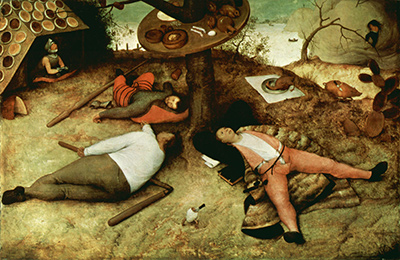Bruegel painted The Land of Cockaigne (Land of Plenty) in 1567 as an oil on panel
It depicted a well-known European myth in true Bruegel style.
The Land of Cockaigne was a dreamlike Garden of Eden where no-one needed to work for a living.
Food and drink arrived in a endless stream of ready-to-eat supplies.
Ironically, this piece still works well today, as a depiction of "living the dream" with our fast-food and ready meals but Bruegel would have created this piece in a way that was understandable to people of his time.
The Land of Cockaigne shows a soldier, peasant and a clerk or burgher lying under a table around a tree.
They have no need for their tools - the gauntlet, the reaper or the leger. Instead they lie, almost stupefied, as the egg runs towards them and the pig presents itself with a carving knife.
A knight in the building roofed with pancake-type food opens his mouth ready for his next piece of food.
A roasted pigeon would have flown towards him but was accidently removed during restoration of the painting.
This is not an idyllic depiction, more an image of greed and laziness. Some critics have suggested that it depicts the complacent Netherlands people prior to the Dutch Revolt.
Some have suggested a Freudian interpretation of simple oral pleasure.
Clearly it show a breakdown in societal classes as the three figures would not have moved within the same circles.
Though they appear to form a triangle it has been suggested that the roasted fowl completes the wheel and possible the fowl symbolizes the humiliation and failure of the nobleman.
Whatever the true meaning is behind the Land of Cockaigne, this iconic image is yet another of Bruegel's wonderful and almost surreal depictions of society, as seem through his eyes.




